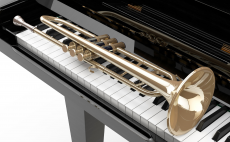
We’ve had quite a close look at both the woodwind and brass families of instruments now, so we fairly certain of how they work and fit together into bigger musical ensembles. But there’s one element of them that I’ve shied away from talking about up till now – the issue of how brass and woodwind instruments are tuned.
Many of the original wind instruments would have been tuned to standard concert pitch, whereby Middle C is the central note that everything else stretches off from. However, as people started to design more and more woodwind instruments, they wanted to give the instruments a broader range, whilst still making them comfortable to hold and play. Since the size of the instruments dictates its pitch as well as the fingerings used, when fingering a C on two different woodwind instruments, two different notes will be played. In an Alto Saxophone, the note played with the C fingering will be an E flat. This would be a problem for players of wind instruments, since they would have to remember to use different fingerings for each instrument they were using to play the same note, so to simplify things for these players, the note names and symbols on music are ‘transposed’. This means that when told to play a C in sheet music, players will use the C fingering regardless of which instrument they are using, however, the note they are playing will not actually be a C. The only problem that remains is that for two instruments to play together, they will have to have two separate pieces of sheet music. Each notated differently. If you want to learn clarinet or saxophone, you will need to get music written specifically for them, since otherwise you will be playing it in a different key.
I know that it’s a confusing concept to get your head around, but some wind instruments are written falsely, so as to help the instrumentalist. One instrument that this is not true of is the Flute. The flute is written in concert pitch, meaning it is easier to play alongside instruments like guitar and piano without sounding out of tune.
For those wanting to get into any of the wind instruments – including either woodwind or brass instruments, there is a very easy place to start. Many school children are offered lessons in recorder or ocarina and it is easy to find these cheaply. They are quite easy instruments to pick up quickly too, so if you want to get into music straight away, this would be your safest bet.
Also, for a fun experiment to try at home, a really simple way to see what it’s like playing a flute is to fill a glass bottle up to halfway with water and to blow across the top of it. If you can get your mouth in the right position then you should hear a flute-like sound. Now try filling up various bottles with different amounts of water. When there is less water in the bottle, you should hear a lower note, and where there is more a higher note. Unfortunately you’ll also find that the higher the note, the harder it is to make.
Now, if you’ve been confused by words like ‘octave’ or any of the other terminology in the articles so far, then don’t worry, because a basic music theory series of articles is coming soon.
Image from: http://i.ytimg.com/vi/tXVCBmseB0I/maxresdefault.jpg

0 Comment:
Be the first one to comment on this article.